

How associative fear memory is formed in the brain: Insights into how pathological fear memory in PTSD could be suppressed. How does the brain form "fear memory" that links a traumatic event to a particular situation?

A pair of researchers at the University of California, Riverside, may have found an answer. Using a mouse model, the researchers demonstrated the formation of fear memory involves the strengthening of neural pathways between two brain areas: the hippocampus, which responds to a particular context and encodes it, and the amygdala, which triggers defensive behavior, including fear responses. Study results appear today in Nature Communications. "It has been hypothesized that fear memory is formed by strengthening the connections between the hippocampus and amygdala," said Jun-Hyeong Cho, an assistant professor in the Department of Molecular, Cell and Systems Biology and the study's lead author. "Experimental evidence, however, has been weak. According to Cho, weakening these connections could erase the fear memory. Post-traumatic stress disorder, or PTSD, affects 7% of the U.S. population.
Neural circuit that drives physical responses to emotional stress found. Researchers at Nagoya University have discovered a neural circuit that drives physical responses to emotional stress.
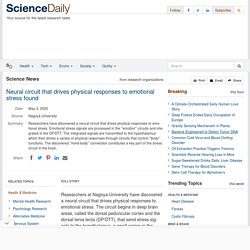
The circuit begins in deep brain areas, called the dorsal peduncular cortex and the dorsal tenia tecta (DP/DTT), that send stress signals to the hypothalamus, a small region in the brain that controls the body's vital functions. The findings were recently published in the journal Science. Emotional stress activates the sympathetic nervous system, which leads to physical responses, such as a rise in blood pressure and body temperature, and a faster heart rate. Such responses are thought to be coping mechanisms in humans and many other mammals to boost physical performance in fight-or-flight situations. But nowadays, when most people rarely encounter such situations, these responses could perhaps have an adverse effect on their health. The tracers showed that specifically the DP/DTT brain areas were highly active when exposed to stress.
International meta-analysis of PTSD genome-wide association studies identifies sex- and ancestry-specific genetic risk loci. Post-Traumatic Stress Disorder after Civilian Traumatic Brain Injury: A Systematic Review and Meta-Analysis of Prevalence Rates. Untitled. Untitled. Objectives: Post-traumatic stress disorder (PTSD) is a common psychiatric disease with changes in neural circuitries.
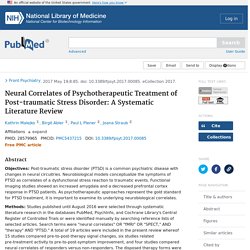
Neurobiological models conceptualize the symptoms of PTSD as correlates of a dysfunctional stress reaction to traumatic events. Functional imaging studies showed an increased amygdala and a decreased prefrontal cortex response in PTSD patients. As psychotherapeutic approaches represent the gold standard for PTSD treatment, it is important to examine its underlying neurobiological correlates. Methods: Studies published until August 2016 were selected through systematic literature research in the databases PubMed, PsychInfo, and Cochrane Library's Central Register of Controlled Trials or were identified manually by searching reference lists of selected articles.
Untitled. Posttraumatic Stress Disorder Prevalence and Risk of Recurrence in Acute Coronary Syndrome Patients: A Meta-analytic Review. Abstract Background Acute coronary syndromes (ACS; myocardial infarction or unstable angina) can induce posttraumatic stress disorder (PTSD), and ACS-induced PTSD may increase patients’ risk for subsequent cardiac events and mortality.
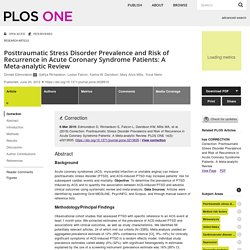
Objective: To determine the prevalence of PTSD induced by ACS and to quantify the association between ACS-induced PTSD and adverse clinical outcomes using systematic review and meta-analysis. Data Sources: Articles were identified by searching Ovid MEDLINE, PsycINFO, and Scopus, and through manual search of reference lists. Methodology/Principal Findings Observational cohort studies that assessed PTSD with specific reference to an ACS event at least 1 month prior.
Conclusions/Significance This meta-analysis suggests that clinically significant PTSD symptoms induced by ACS are moderately prevalent and are associated with increased risk for recurrent cardiac events and mortality. Received: February 20, 2012; Accepted: May 14, 2012; Published: June 20, 2012.
Deficiency of Inflammatory Response to Acute Trauma Exposure as a Neuroimmune Mechanism Driving the Development of Chronic PTSD: Another Paradigmatic Shift for the Conceptualization of Stress-Related Disorders? - PubMed. Grey Matter Density Changes of Structures Involved in Posttraumatic Stress Disorder (PTSD) After Recovery Following Eye Movement Desensitization and Reprocessing (EMDR) Therapy - PubMed. Functional Neuroanatomy of Emotion and Its Regulation in PTSD. A Systematic Review and Meta-analysis on PTSD Following TBI Among Military/Veteran and Civilian Populations - PubMed.
Objectives: To determine whether persons with traumatic brain injury (TBI) are at greater risk of developing posttraumatic stress disorder (PTSD) than other trauma-exposed populations without TBI, and whether this risk is even greater in military/veteran settings than in civilian settings.
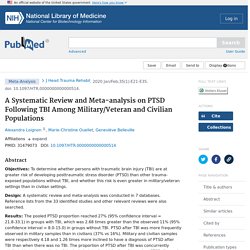
Design: A systematic review and meta-analysis was conducted in 7 databases. Reference lists from the 33 identified studies and other relevant reviews were also searched. Results: The pooled PTSD proportion reached 27% (95% confidence interval = 21.8-33.1) in groups with TBI, which was 2.68 times greater than the observed 11% (95% confidence interval = 8.0-15.0) in groups without TBI. PTSD after TBI was more frequently observed in military samples than in civilians (37% vs 16%). Military and civilian samples were respectively 4.18 and 1.26 times more inclined to have a diagnosis of PTSD after TBI than when there was no TBI.
The Failing Cascade: Comorbid Post Traumatic Stress- And Opioid Use Disorders - PubMed. Brain Structure in Childhood Maltreatment-Related PTSD Across the Lifespan: A Systematic Review - PubMed. Numerous deleterious outcomes are associated with child maltreatment, and PTSD secondary to maltreatment is one of the most commonly cited diagnoses that may follow individuals throughout their lives.

Recent neuroimaging research has observed significant structural abnormalities in individuals with maltreatment-related PTSD (m-PTSD) compared to maltreated individuals without PTSD and healthy controls. Therefore, the aims of this systematic review were to summarize the literature on brain structure in m-PTSD, identify methodological challenges and limitations, and provide directions for future research. Preferred Reporting Items for Systematic Reviews and Meta-Analyses guidelines were followed to conduct a systematic search across three databases, and 18 studies were identified for inclusion, including 10 pediatric, 1 adolescent, and 7 adult studies. Psychiatria Polska - _789_806_ Psychiatr.

Pol. 2019; 53(4): 789–806 Jan Aleksander Beszłej, Tomasz Wieczorek, Agnieszka Kobyłko, Patryk Piotrowski, Damian Siwicki, Artur Weiser, Karolina Fila-Witecka, Joanna Rymaszewska, Paweł Tabakow Summary Deep brain stimulation (DBS) is a treatment method that is currently getting more and more attention from psychiatrists. Treatment for Posttraumatic Stress Disorder in Patients With a History of Traumatic Brain Injury: A Systematic Review - PubMed. Post-Traumatic Stress Disorder after Civilian Traumatic Brain Injury: A Systematic Review and Meta-Analysis of Prevalence Rates. Neurobiological links between stress and anxiety. Heart and Brain Interaction of Psychiatric Illness: A Review Focused on Heart Rate Variability, Cognitive Function, and Quantitative Electroencephalography. Transcranial Magnetic Stimulation in Anxiety and Trauma-Related Disorders: A Systematic Review and Meta-Analysis - PubMed. AKG receives research support from NIMH AAN reports the following disclosures: Abbott Laboratories, Alkermes, American Psychiatric Association, Appliance Computing Inc.
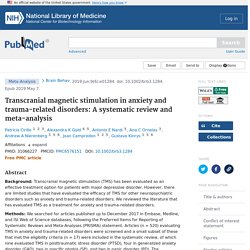
(Mindsite), Basliea, Brain Cells, Inc., Brandeis University, Bristol Myers Squibb, Clintara, Corcept, Dey Pharmaceuticals, Dainippon Sumitomo (now Sunovion), Eli Lilly and Company, EpiQ, L.P. The Effectiveness of Cannabinoids in the Treatment of Posttraumatic Stress Disorder (PTSD): A Systematic Review - PubMed. Objectives: Posttraumatic stress disorder (PTSD) is a potentially debilitating mental health problem.
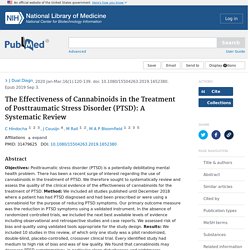
There has been a recent surge of interest regarding the use of cannabinoids in the treatment of PTSD. We therefore sought to systematically review and assess the quality of the clinical evidence of the effectiveness of cannabinoids for the treatment of PTSD. Method: We included all studies published until December 2018 where a patient has had PTSD diagnosed and had been prescribed or were using a cannabinoid for the purpose of reducing PTSD symptoms. Our primary outcome measure was the reduction in PTSD symptoms using a validated instrument.
MRI Findings in Posttraumatic Stress Disorder - PubMed. Posttraumatic stress disorder (PTSD) is a psychiatric condition that develops after a person experiences one or more traumatic events, characterized by intrusive recollection, avoidance of trauma-related events, hyperarousal, and negative cognitions and mood.

Neurophysiological evidence suggests that the development of PTSD is ascribed to functional abnormalities in fear learning, threat detection, executive function and emotional regulation, and contextual processing. Magnetic resonance imaging (MRI) plays a primary role in both structural and functional neuroimaging for PTSD, demonstrating focal atrophy of the gray matter, altered fractional anisotropy, and altered focal neural activity and functional connectivity. Keywords: diffusion tensor imaging; posttraumatic stress disorder; resting state functional MRI; spontaneous neural activity; voxel-based morphometry. Neuromodulatory Treatments for Post-Traumatic Stress Disorder (PTSD) - PubMed.
Changes in Inflammatory Biomarkers Before and After SSRI Therapy in PTSD: A Review - PubMed. Background: Selective serotonin reuptake inhibitors (SSRIs) are regarded as the standard pharmacotherapy for the treatment of posttraumatic stress disorder (PTSD). Recent studies indicate that neuroinflammation is associated with PTSD. We conducted a search of the literature to determine if SSRI efficacy is associated with a decrease in inflammation levels. Methods: A literature search was conducted to identify studies published from January 2000 to January 2019 that measured changes in inflammatory biomarkers before and after SSRI treatment in patients with PTSD. Results: Four studies met the criteria for inclusion.
In one study, SSRI use significantly reduced interleukein-1beta. Conclusions: Our review had mixed results regarding whether SSRI therapy for PTSD is associated with a reduction in inflammation. A Systematic Review and Meta-Analysis of Magnetic Resonance Imaging Measurement of Structural Volumes in Posttraumatic Stress Disorder - PubMed. Amygdala, Hippocampus, and Ventral Medial Prefrontal Cortex Volumes Differ in Maltreated Youth with and without Chronic Posttraumatic Stress Disorder. Abnormal Structure of Fear Circuitry in Pediatric Post-Traumatic Stress Disorder. [Neurological Mechanism and Therapeutic Strategy for Posttraumatic Stress Disorders] - PubMed. Clinical Therapeutic Strategy and Neuronal Mechanism Underlying Post-Traumatic Stress Disorder (PTSD) Cannabinoid Interventions for PTSD: Where to Next? - PubMed. Herschel Walker: Living Legend. Reduce fear in Memory Daniela Schiller.
It was a Saturday night at the New York Psychoanalytic Institute, and the second-floor auditorium held an odd mix of gray-haired, cerebral Upper East Side types and young, scruffy downtown grad students in black denim. Up on the stage, neuroscientist Daniela Schiller, a riveting figure with her long, straight hair and impossibly erect posture, paused briefly from what she was doing to deliver a mini-lecture about memory. She explained how recent research, including her own, has shown that memories are not unchanging physical traces in the brain. Instead, they are malleable constructs that may be rebuilt every time they are recalled. The research suggests, she said, that doctors (and psychotherapists) might be able to use this knowledge to help patients block the fearful emotions they experience when recalling a traumatic event, converting chronic sources of debilitating anxiety into benign trips down memory lane. Fear training Moment of silence Altering the story The safest memories.
Fear: Replacing Memories. January 04, 2010 The human brain goes through a complex process to form and consolidate memories. But is it possible to replace memories of fearful events, and in doing so, assist in the treatment of patients suffering from the debilitating effects of post-traumatic stress disorder or other anxiety disorders? Dr.Joseph LeDoux and a team of New York University neuroscientists think they have found a way to replace traumatic memories through therapy.
Download this video. Watch on YouTube. Introduction: Welcome to “Speaking of Science”, the National Institute of Mental Health presents a series of conversations with innovative researchers working in a wide range of disciplines to pave the way for the prevention, recovery, and cure of mental illness. Narrator: We all have difficult sometimes painful memories stored in our minds.